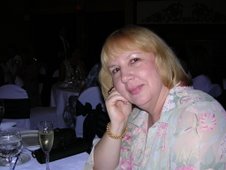May 19, 2007
This morning we left Hama, Syria, the fourth largest city in Syria, which is some forty miles from the Mediterranean Sea. Hama is within the Fertile Crescent, an downward shaping arc goes around the northern edge of the Shamiyeh desert. The Fertile Crescent is basically located on or near the waterways in the region, the Mediterranean and the Euphrates River. It arcs from the Tigris and Euphrates rivers in southern Iraq, then northward around the desert, then back to the south alone the eastern edge of the Mediterranean, and then into northern Egypt. It was obvious to us that outside the Fertile Crescent area is nothing but desert.
Palmyra is along the ancient trade route that crossed the desert, making a straight line from the Mediterranean to the Iraq. It was in its heyday at the time of Christ. The trade route changed when the town was devastated by the Mongols in the late 13th century, and then later abandoned under the Ottoman Empire. Some of the ruins at Palmyra are nearly 4,000 years old. The Palmyra area contains the largest ruin field in the world.
On the road to Palmyra we could see the dramatic shift in the environment, from lush vegetation, to sporadic vegetation, to rocky desert. It happens very quickly, within 45 minutes. In the desert we came within 90 miles of Baghdad. We stopped at the “Bagdad” Café, a small partially-tent structure in the middle of nowhere. It is owned and run by Bedouins, who hand-make beautiful jewelry. I was talking to one of the young Bedouin traders, and wanted to buy something, but had unfortunately not been able to cash a traveler’s check anywhere in Syria. They wouldn’t cash traveler’s checks even at the best hotels in Damascus. I said to him “My friend, you do not take traveler’s checks here, do you?” He gave me a puzzled look, and replied, “Sir, we Bedouins . . . we in desert! We both had a good laugh.
We had an amazing time walking through the ruins. When you see the size of the limestone and granite columns and ponder the construction techniques involved in raising the huge stone beams fifty feet into the air, you get a real appreciation for the magnitude of the efforts made by previous Syrians, especially when you imagine what the original structures looked like. It boggles the mind.
When the provincial governor heard of our visiting his territory, he offered us a private invitation to the Festival of Syrian History, expressed in dance, the final performance of which was to be given in the ancient Roman-style open theatre in the ruins, the evening we were there. We were delighted to attend. The performance was at night; it was the best dance troupes of the entire country of Syria. There were magnificent lighting effects on the ancient stone stage background. The costumes were unbelievable and the dancers were spectacular. It was an extraordinary event, one which I will never forget.
Before the show, we went up to the Arab Castle, on top of the mountain overlooking the Palmyran ruins. All-in-all, it was another extraordinary day.
 The Palmyra ruin field
The Palmyra ruin field The world's largest ruin field
The world's largest ruin field A BIG gravemarker
A BIG gravemarker Just holding things together
Just holding things together Palmyra Ruins
Palmyra Ruins Palmyra ruins and the Arab Castle
Palmyra ruins and the Arab Castle.jpg) The Baghdad Cafe
The Baghdad Cafe







.jpg) The Baghdad Cafe
The Baghdad Cafe


















